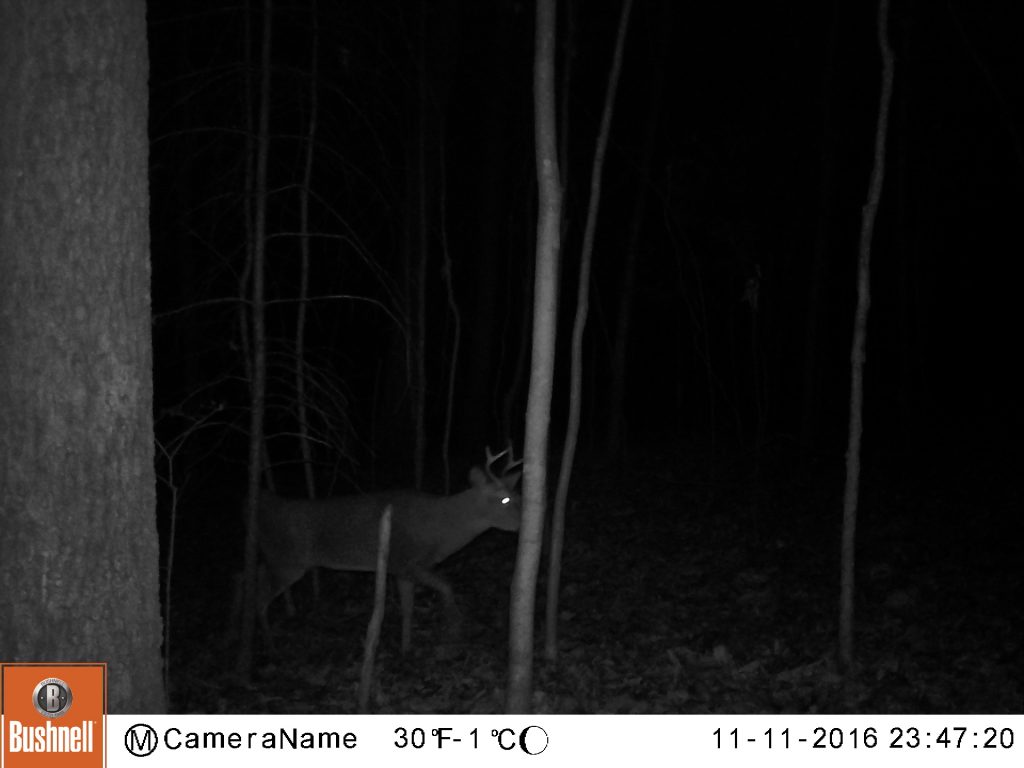If you have ever spoken to a hunter seeking his quarry, the phase “go nocturnal” often sneaks in. It refers to deer changing their activity pattern with increased hunting pressure – moving more after dark than during daylight (i.e. legal hunting hours).
During the rifle season we obtain locations every 20 minutes on bucks. What a great opportunity to see if the infamous “go noctural” is true. And even better, our collared deer are at least 2.5 years old. Some are now at least 5.5 years old. So they’ve been around the block a time or two when it comes to hunting season.
I took all our data from 2013, 2014, and 2015 and calculated the speed (meters per hour) every 20 minutes that every deer traveled during the rifle season.
And because behavior during the first three days (when the most hunting pressure occurs) might be different from the rest of the hunting season, I summarized the data for Monday-Wednesday after the opener and then for the remaining nine days (Thursday through Saturday).
Take a look! Legal hunting hours are about 7am to 5pm (highlighted in yellow). The least movement occurs between 9am and 4pm, with peak movement occurring 6am-8am and 5pm-7pm.
The peak speed is about 180 m/hr just before sunrise and just after sunset. From 10pm to 6am it’s about 60-80 m/hr. During the day movement is at its lowest when deer move about 40 m/hr.

Now let’s take a look at what they do later in the rifle season. Just about the same thing, but peak speeds are reduced to 100-140 m/hr. Notice that nighttime speeds dropped to about 60 m/hr, and daytime speeds dropped to about 30 m/hr. Clearly deer are responding to hunting pressure and reducing their movements.

Of course, if you’re a devoted reader of this blog that’s not surprising. We have shared with you that daytime home ranges are only about 100 acres during the rifle season.
So is this proof that bucks go nocturnal? I’m not so sure.
Deer are a crepuscular animals by nature, meaning they are most active around sunrise and sunset. Perhaps the data from our deer suggest they shifted their movements more to the darker side of sunrise and sunset.
Unfortunately, we don’t collect locations on bucks every 20 minutes outside the rifle season. However, we do collect these data for does with fawns. So let’s look at their data for October and see when they are active.

First, keep in mind that daylength is slightly longer (7am-7pm). Movement peaks about 8am in the morning and just after sunset. If you ask me, it doesn’t look that much different from bucks in rifle season except the peak is lower at sunrise and slightly more active in the few hours after sunrise. However, given the amount of early morning hunting activity in rifle season, those differences are not surprising.
So I’m afraid I don’t buy into the theory that deer “go nocturnal” during the rifle season. They’re clearly crepuscular and reducing their movements overall. But they’re certainly not becoming vampires!
The bummer is that bucks are not moving much during the middle of the day. But take heart, there are always exceptions to the rule! I plotted the maximum speeds of deer and any time, day or night, you can find deer moving over one mile in an hour!

Remember, averages are just that – an average – and do not reflect the variability in behavior.
Also, in my hunting experience in Pennsylvania (and other places), there seem to be a lot fewer hunters in the woods by the time lunch hour rolls around. Pack a lunch and see what other hunters are missing.
Watch this buck during the 2013 rifle season (we start the movie on Sunday, December 1, 2013). If any deer might be called nocturnal, it could be him because he makes long-distance movements at night.
But pay attention to his moves in the early afternoon. Even on opening day by 2pm, he has started to make substantial movements. And he does this more than once.
The other thing I love about this buck…he hides on public land! Where does he go at night? Down in the valley on private land but his hiding spot during the day is on public land.
-Duane Diefenbach
If you would like to receive email alerts of new blog posts, subscribe here.
And Follow us on Twitter @WTDresearch
